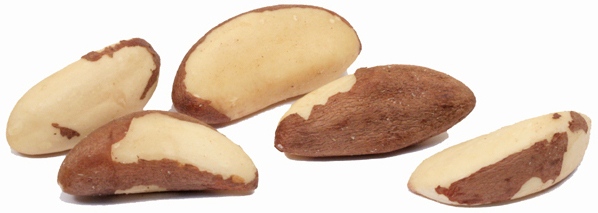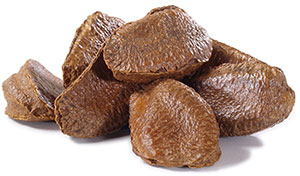

Brazil Nuts

Bertholletia. (For Louis Claud Berthollet (1748- 1822), french chemist.) Lecythidaceae. One species, a deciduous tree, to 50m. Young branches glabrous, Leafy at the tips. Leaves to 36 x 15cm, alternate, short-stalked, oblong, apiculate to mucronate, glabrous, leathery, margin entire or slightly crenate, undulate; petiole to 3.5cm. Flowers in erect axillary or terminal panicles, to 3cm diameter; pedicels stout, to 1mm; sepels 2, oblong-obovate, to 14mm; petals 6, unequal, oblong-ovate, pale yellow or white, to 30mm; stamens numerous, fused to form a thick, white or yellow flap, the androecial hood, on the lower side of the flower; style short; ovary 4-celled,inferior. Fruit globose, woody, brown, to 15cm diameter, with a thick outer shell; seeds 12-24, angular, woody, to 5cm. Amazonia. Z10. CultivationBertholletia occurs naturally in deep rich alluvial soils, on slightly raised ground that is not subject to regular or extensive flooding. It is one of the tallest trees of the Amazon forest, up to 40m tall, 1.8m in diameter, with a characteristically long straight trunk, branching only at the top. The creamy white flowers, carried at the branch ends, give rise to large spherical fruits with a hard woody casing, not unlike a coconut in appearance, inside which 12-24 brazil nuts are packed like the segments of an orange. They take about 14 months to mature, dropping when ripe and are collected by the castanheiros (since the entire fruit can weigh almost 2kg, and may drop 40m, this is a dangerous occupation). The harvest is gathered in the rainy season, the nuts graded by flotation, and transported by water. In temperate climates, Bertholletia is sometimes found in educational collections of economic plants, where it is grown under hot glasshouse conditions as a small plant, pruned in winter to restrict size, sown at 21-25şC, after removing a portion of the hard shell to allow entry of moisture. There is great deal of seedling variation, and grafting is practised in commercial cultivation. Bertholletia excelsa, is the principal species of this genus.
|
Home
Grow Herbs
Grow Fruit
Grow Vegetables
Cyberian Index
If you like this website and want one of your own contact
Cyberian All information correct at
time of publication and open to updates as necessary. No part of this website,
or its vectors, may be produced in any shape or form, using any type or design
of medium, system, equipment or otherwise without the prior written consensual
notice of the Cyberian. Any breach of these requirements will result in the
appropriate action. If in doubt, e-mail contact is recommended.
Some components of this website were obtained as open-source software and are
used in the same non-profit manner on this website.